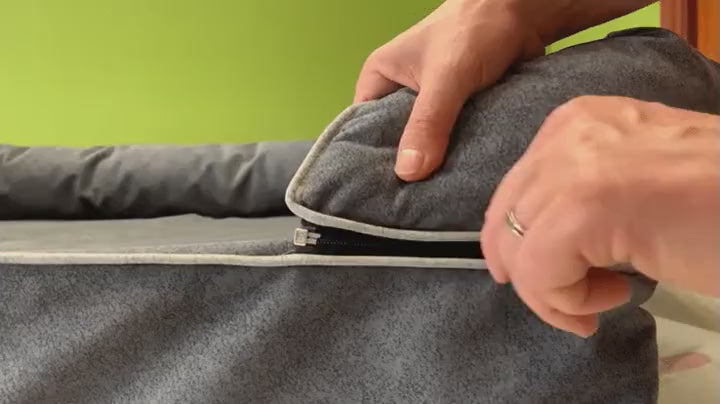Have you ever encountered situations that have led you to ask yourself these questions: my dog doesn't want to walk and cries or why my cat crawls and does not walk? It is very striking to see that our furry friends, as much as they love it, are unable to run, or start to complain when they start their movements.
Let's take a look at some possible reasons so you can find out why my dog walks and sits, or why my dog can't move and cries when trying to move.
Reasons why your dog doesn't want to walk.
Canine arthritis and osteoarthritis
"My dog doesn't want to walk; is he in pain?"
The first answer that comes to mind for almost all of us who know the physiognomy of our best friends well is osteoarthritis or osteoarthritis.
Both conditions are degenerative in nature and consist of a joint inflammation, caused by a progressive deterioration of the cartilage that is part of the joints. The pain causes the dog to stop walking little by little, and complains every time it tries to walk.
It is a very common ailment in elderly dogs, and also widespread in overweight dogs. As a result of being immobilized, the dog will begin to suffer from muscle atrophy, so it will be increasingly difficult for him to move.
The solution involves rehabilitation sessions together with the administration of natural anti-inflammatories for dogs such as turmeric, highly concentrated in the Baluka vitamin complex (balukaVIT), specially designed to help your best friend if he suffers from joint inflammations.
Hip dysplasia
Hip dysplasia in dogs is a disease that mainly affects large and elderly dogs, and is very common in breeds such as Labrador, Golden Retriever and German Shepherd. It consists of a deformation of the femoral head and the acetabulum (the hollow where the femur is lodged in the pelvis), so that it prevents the normal play of the joint.
Dogs suffering from dysplasia have clear difficulty getting up and walking because of pain from a joint that does not function as it should.
To treat dysplasia, apreventive surgery is usually performed on dogs predisposed to suffer it in the future, without forgetting a veterinary treatment based on chondroprotectors: food supplements for dogs that promote the development of cartilage (hyaluronic acid, glucosamine, chondroitin sulfate) which, in combination with a natural anti-inflammatory (such as turmeric), will help your dog to mitigate the pain and inflammation in the hip.
Our Viscoelastic Bed for Dogs
Has his name embroidered on it
Cares for his bones
Best for dogs with dysplasia or osteoarthritis.
Necrosis of the femur head
Unlike dysplasia, this disease mainly affects young dogs and small breeds, such as Chihuahua, Pomeranian, Beagle, Maltese Bichon, Yorkshire Terrier, Teckel... It consists of a lack of blood supply to the head of the femur during the growth stage.
Consequently, the dog suffering from this disease will practically stop walking completely. The lack of mobility will also cause the muscles of this limb to atrophy, which will introduce the animal into a vicious circle.
The treatment will inevitably be of asurgical nature : your dog will need surgery to remove the necrotic (dead) tissue attached to the head or neck of the femur.
Canine degenerative myelopathy
In this case, we are talking about a deterioration of the spinal cord that mainly affects the mobility of the animal's hind legs, to the point of losing all control over them. Its origin can be due to endocrine, orthopedic or nervous problems, or as a consequence of a strong trauma to the back.
Unfortunately, there is no definitive treatment for degenerative myelopathy, and dogs suffering from it rely entirely on physiotherapy to mitigate muscle atrophy, and holistic methods, the effect of which is often associated more with placebo.
Cruciate ligament rupture
Common in small-sized dogs and elderly dogs, it consists of a total or partial rupture of one of the knee ligaments, so that the dog, consumed by pain, stops walking almost completely. Obviously, the joint will cease to function properly.
Fortunately, this type of injury can be treated by a surgery and a subsequent administration of anti-inflammatory drugs, supported by sessions of physiotherapeutic rehabilitation.
Other possible causes
- Violent traumas that cause punctual damage to the extremities.
- Encephalitis caused by the distemper virus, resulting in incoordination.
- Intoxications that can cause paralysis, accompanied by spasms and vomiting or hemorrhagic diarrhea.
- Diseases metabolic, nervous or developed during gestation.
Natural Anti-inflammatory for Dogs and Cats
A plus of VITality
The VITamins your dog needs
Turmeric as a natural anti-inflammatory
If you notice that your dog does not want to walk and cries when trying to do so, it is very likely that he is suffering from one of the pathologies described above.
As you have seen, joint inflammations are the most common cause of our best friends' refusal to move. Fortunately, there are treatments that can help dogs and cats to recover their mobility, especially when they act in combination with natural anti-inflammatories, such as our balukaVIT® vitamin supplement with turmeric..
But remember, these are just tips. You should always rely on the expertise of a veterinarian to analyze the case.

















